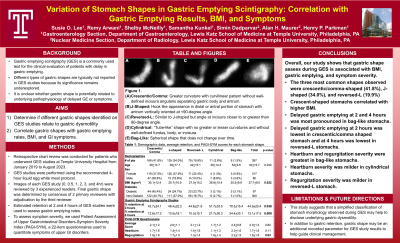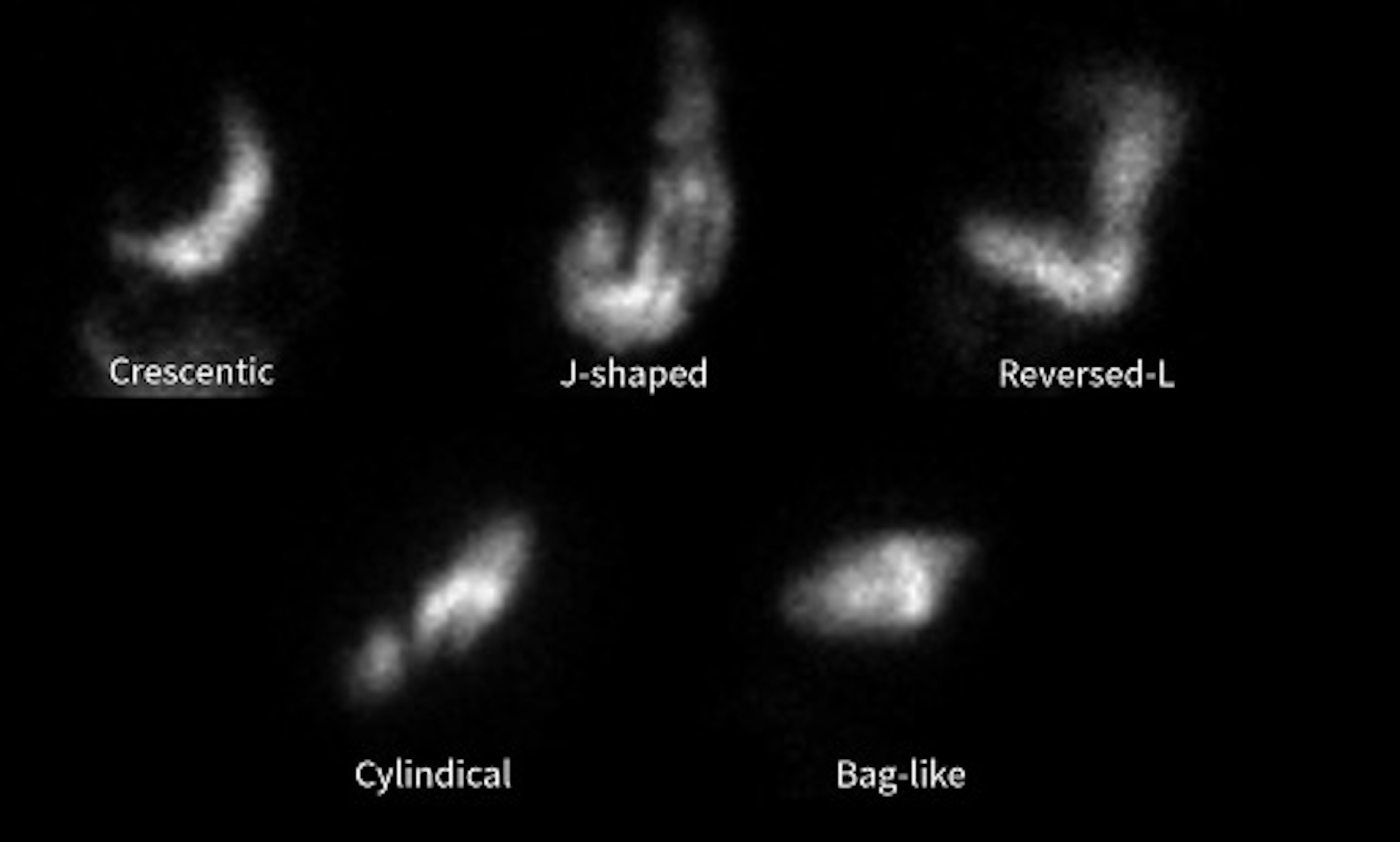Sunday Poster Session
Category: Functional Bowel Disease
P0638 - Variation of Stomach Shapes in Gastric Emptying Scintigraphy: Correlation with Gastric Emptying Results, BMI, and Symptoms
Sunday, October 27, 2024
3:30 PM - 7:00 PM ET
Location: Exhibit Hall E

Has Audio
- SL
Susie O. Lee, MD
Lewis Katz School of Medicine at Temple University
Los Angeles, CA
Presenting Author(s)
Award: Presidential Poster Award
Susie O.. Lee, MD1, Remy Arwani, MBBCh2, Shelby McNeilly, DO3, Samantha Kunkel, BA3, Arvind Bussetty, MD4, Simindokht Dadparvar, MD2, Alan Maurer, MD5, Henry P. Parkman, MD3
1Lewis Katz School of Medicine at Temple University, Los Angeles, CA; 2Lewis Katz School of Medicine at Temple University, Philadelphia, PA; 3Temple University, Philadelphia, PA; 4Robert Wood Johnson Medical School, Rutgers University, New Brunswick, NJ; 5Temple University, Katz School of Medicine, Philadelphia, PA
Introduction: The stomach can vary in shape among different people. These different types of gastric shapes are encountered in gastric emptying scintigraphy (GES). It is not known if the different gastric shapes have significance, such as whether gastric shapes are related to underlying pathophysiology of delayed GE or symptoms. The influence of stomach shapes on gastric emptying (GE) and patient symptoms remains unexplored. The aim of this study is to investigate different stomach shapes observed during GES and examine their potential associations with BMI, GE rate, and gastrointestinal (GI) symptoms.
Methods: This was a retrospective review of GES studies performed at our tertiary care institution. Studies from patients with prior gastric surgery were excluded. A classification of gastric shapes included: crescentic, J-shaped, reversed-L, cylindrical and bag-like. Gastric shapes were correlated with BMI, GE rate, and GI symptoms (quantified using PAGI-SYM).
Results: 426 consecutive GES studies were reviewed (338 females, 88 males, average age 40.0±15.7 years, average BMI 27.7±9.0 kg/m2). Gastric shapes were: 39% crescentic/comma-shaped, 32% J-shaped, 19% reversed L-shape, 3% cylindrical and 1% bag-like. BMI was highest in crescentic/comma-shaped stomachs (30.1±12.4 kg/m2) and lowest in bag-like stomachs (25.2±9.9 kg/m2; p=0.022). Delayed GE was present in 50% of bag-like stomachs compared to 20-30% for the other groups. Delayed GE was most pronounced in bag-like stomachs (34.4±33.1% retention at 4 hours) and lowest in reversed-L shape (10.3±15.7% retention at 4 hours; p=0.008). Regurgitation severity was greatest in bag-like stomachs (2.2±1.5) compared to milder symptoms in reversed-L shape (1.3±1.4; p=0.03). Heartburn severity was increased in bag-like stomachs (2.3±1.6) while patients with cylindrical stomachs reported least heartburn severity (1.1±1.3; p=0.11).
Discussion: A classification system based on five gastric shapes observed during GES showed that crescent-shaped stomach was the most common shape and correlated with higher BMIs. Delayed GE was most pronounced in bag-like stomachs and lowest in reversed-L stomachs. Among symptoms, regurgitation and heartburn severity were greatest in the bag-like stomachs, contrasting with milder symptoms in the reversed-L stomachs. Characterization of gastric shape provides information that relates to gastric emptying and symptoms; whether gastric shape influences treatment outcome remains to be determined.

Note: The table for this abstract can be viewed in the ePoster Gallery section of the ACG 2024 ePoster Site or in The American Journal of Gastroenterology's abstract supplement issue, both of which will be available starting October 27, 2024.
Disclosures:
Susie O.. Lee, MD1, Remy Arwani, MBBCh2, Shelby McNeilly, DO3, Samantha Kunkel, BA3, Arvind Bussetty, MD4, Simindokht Dadparvar, MD2, Alan Maurer, MD5, Henry P. Parkman, MD3. P0638 - Variation of Stomach Shapes in Gastric Emptying Scintigraphy: Correlation with Gastric Emptying Results, BMI, and Symptoms, ACG 2024 Annual Scientific Meeting Abstracts. Philadelphia, PA: American College of Gastroenterology.
Susie O.. Lee, MD1, Remy Arwani, MBBCh2, Shelby McNeilly, DO3, Samantha Kunkel, BA3, Arvind Bussetty, MD4, Simindokht Dadparvar, MD2, Alan Maurer, MD5, Henry P. Parkman, MD3
1Lewis Katz School of Medicine at Temple University, Los Angeles, CA; 2Lewis Katz School of Medicine at Temple University, Philadelphia, PA; 3Temple University, Philadelphia, PA; 4Robert Wood Johnson Medical School, Rutgers University, New Brunswick, NJ; 5Temple University, Katz School of Medicine, Philadelphia, PA
Introduction: The stomach can vary in shape among different people. These different types of gastric shapes are encountered in gastric emptying scintigraphy (GES). It is not known if the different gastric shapes have significance, such as whether gastric shapes are related to underlying pathophysiology of delayed GE or symptoms. The influence of stomach shapes on gastric emptying (GE) and patient symptoms remains unexplored. The aim of this study is to investigate different stomach shapes observed during GES and examine their potential associations with BMI, GE rate, and gastrointestinal (GI) symptoms.
Methods: This was a retrospective review of GES studies performed at our tertiary care institution. Studies from patients with prior gastric surgery were excluded. A classification of gastric shapes included: crescentic, J-shaped, reversed-L, cylindrical and bag-like. Gastric shapes were correlated with BMI, GE rate, and GI symptoms (quantified using PAGI-SYM).
Results: 426 consecutive GES studies were reviewed (338 females, 88 males, average age 40.0±15.7 years, average BMI 27.7±9.0 kg/m2). Gastric shapes were: 39% crescentic/comma-shaped, 32% J-shaped, 19% reversed L-shape, 3% cylindrical and 1% bag-like. BMI was highest in crescentic/comma-shaped stomachs (30.1±12.4 kg/m2) and lowest in bag-like stomachs (25.2±9.9 kg/m2; p=0.022). Delayed GE was present in 50% of bag-like stomachs compared to 20-30% for the other groups. Delayed GE was most pronounced in bag-like stomachs (34.4±33.1% retention at 4 hours) and lowest in reversed-L shape (10.3±15.7% retention at 4 hours; p=0.008). Regurgitation severity was greatest in bag-like stomachs (2.2±1.5) compared to milder symptoms in reversed-L shape (1.3±1.4; p=0.03). Heartburn severity was increased in bag-like stomachs (2.3±1.6) while patients with cylindrical stomachs reported least heartburn severity (1.1±1.3; p=0.11).
Discussion: A classification system based on five gastric shapes observed during GES showed that crescent-shaped stomach was the most common shape and correlated with higher BMIs. Delayed GE was most pronounced in bag-like stomachs and lowest in reversed-L stomachs. Among symptoms, regurgitation and heartburn severity were greatest in the bag-like stomachs, contrasting with milder symptoms in the reversed-L stomachs. Characterization of gastric shape provides information that relates to gastric emptying and symptoms; whether gastric shape influences treatment outcome remains to be determined.

Figure: Figure 1. Different shapes of the stomach during GES
Note: The table for this abstract can be viewed in the ePoster Gallery section of the ACG 2024 ePoster Site or in The American Journal of Gastroenterology's abstract supplement issue, both of which will be available starting October 27, 2024.
Disclosures:
Susie Lee indicated no relevant financial relationships.
Remy Arwani indicated no relevant financial relationships.
Shelby McNeilly indicated no relevant financial relationships.
Samantha Kunkel indicated no relevant financial relationships.
Arvind Bussetty indicated no relevant financial relationships.
Simindokht Dadparvar indicated no relevant financial relationships.
Alan Maurer: ICON Medical Imaging – Consultant, Employee.
Henry Parkman: Alimetry – Grant/Research Support. Cin Dom Pharma – Consultant. Evoke Pharma – Consultant. Medtronic Enterra – Consultant. Takeda Pharma – Consultant.
Susie O.. Lee, MD1, Remy Arwani, MBBCh2, Shelby McNeilly, DO3, Samantha Kunkel, BA3, Arvind Bussetty, MD4, Simindokht Dadparvar, MD2, Alan Maurer, MD5, Henry P. Parkman, MD3. P0638 - Variation of Stomach Shapes in Gastric Emptying Scintigraphy: Correlation with Gastric Emptying Results, BMI, and Symptoms, ACG 2024 Annual Scientific Meeting Abstracts. Philadelphia, PA: American College of Gastroenterology.


